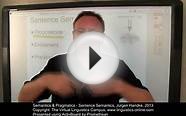
Sentence semantics
Semantics refers to the meaning level of language. It is usually thought of as sitting "above" the syntactic level, and just "below" the level of non-linguistic cognition. Before discussing semantic structure, let's look at the traditional way of diagramming sentence syntax. Here are the syntactical "trees" of a few simple sentences:
S stands for sentence, NP for noun phrase, VP for verb phrase, N for noun, V for verb, pn for pronoun, det for determinative (e.g. "the"), adj for adjective, and aux for auxiliary.
Linguists also have a few ways of diagramming the semantics or meaning relationships of a sentence. Here are the semantic "trees" of those same sentences:
Notice that arguments and predicates are "broader" than things like nouns and verbs. They point at entire meaningful objects and events.
Chomsky and others introduced the idea of surface and deep structures in syntax. This is also considered in semantics. The big difference between the surface semantics style of diagram and those used to diagram the deep structure of semantics is that the deep version is less linear. In this way, they are further from the linear nature of spoken language and closer to the non-linear nature of cognition. Here are those same sentences diagrammed in a way that shows their "deep" semantic structures:
Notice that the arguments are in the circles, and the predicates are indicated by lines, some with arrows. Notice also that adjectives are treated the same way as intransitive verbs, and prepositional phrases are treated the same way as transitive verbs. Determinatives, plurality, tense, auxiliaries, etc., are treated as part of the argument or predicate they refer to.
Here you can look at all three diagrammatic representations at once:
This is an example of a qualifying predication, as represented on the syntactic level by a prepositional phrase:
Here is a sentence with a qualifying predicatiion represented by a relative clause:
Next, we have three examples of embedded predications:
Finally, several examples of more complex or just plain odd sentences:
Examples are from Geoffrey Leech's Semantics (Penguin, 1974)
harry potter pets advantage pets legendary adopt me pets i love vip pets craigslist pets nashville tn wet pets dothan alabama wow classic best hunter pets county pets best turtles for pets adopt pets recycler pets pets 2 barbie pets wonder pets toys reptile pets my pets vet lists of pets forever pets pratt's pets paradise pets mvp pets safari pets craigslist pittsburgh pets food names for pets my pets wellness ebay pets craigslist free pets heartland pets cbd for pets neon adopt me pets craigslist pets bakersfield pets for adoption near me pets at home craigslist albuquerque pets a to z pets touch bar pets craigslist pensacola pets desk pets craglist pets cemetery for petsYou might also like


|
Making the Bride's Father's Speech: Know What to Say and When to Say It - Be Positive, Humorous and Sensitive - Deliver the Memorable Speech (Essentials) Book (How To Books)
|
|
Logic-Based Program Synthesis and Transformation: 24th International Symposium, LOPSTR 2014, Canterbury, UK, September 9-11, 2014. Revised Selected Papers (Lecture Notes in Computer Science) eBooks (Springer) |





